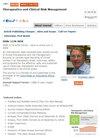牙科治疗静脉镇静与鼻内给氧期间口腔内氧气浓度分析
IF 2.8
3区 医学
Q1 Pharmacology, Toxicology and Pharmaceutics
引用次数: 0
摘要
目的:使用异丙酚(PPF)进行静脉镇静(IVS)是牙科治疗中的常见方法,尤其是对于牙科恐惧症、吞咽反射或接受种植手术的患者,因为异丙酚具有快速诱导和恢复的优点。然而,PPF 和其他静脉镇静剂可能会导致呼吸抑制。因此,使用 PPF 进行静脉注射时需要给氧。但当高浓度氧气储存在口腔中并着火时,可能会发生气道烧伤。因此,本研究旨在阐明使用 PPF 进行静脉输液和给氧时氧气浓度(OC)的变化:19名健康男性志愿者参加了研究。他们都没有牙齿缺失、鼻塞或颞下颌关节功能障碍。他们被连续注射 6 毫克/千克/小时的 PPF 镇静剂,持续 25 分钟,然后通过鼻插管吸入 3 升/分钟的氧气。在输注 PPF 前(基线)和输注开始后 14、15-18(第一阶段)、19 和 20-23 分钟(第二阶段),分别在上颌前牙正中(MMAT)和上颌软腭正中(MMSP)两个部位测量 OC:与基线值相比,MMSP的OC在每个时间点都显著增加,而MMAT的OC在第2阶段显著增加。此外,在使用口托前后的OC比较中,OC呈上升趋势,但在MMAT和MMSP中,两个时间点之间没有观察到有统计学意义的差异。在使用 PPF 和氧气的 IVS 中,咽部的 OC 会随着镇静剂浓度的加深而增加:结论:在使用 PPF 和给氧的静脉输液过程中进行火花程序时,应暂时停止给氧,并进行抽吸以减少口腔中的 OC。本文章由计算机程序翻译,如有差异,请以英文原文为准。
Analysis of Oxygen Concentration in the Oral Cavity During Intravenous Sedation with Intranasal Oxygen Administration for Dental Treatment
Purpose: Intravenous sedation (IVS) with propofol (PPF) is commonly performed in dental treatment, particular in patients with dentophobia, with gag reflex, or undergoing implant surgeries, as PPF has the advantages of rapid induction and recovery. However, PPF and other intravenous sedatives may cause respiratory depression. Thus, IVS with PPF requires oxygen administration. But airway burn may occur when high-concentration oxygen is stored in the oral cavity and catches fire. For these reasons, the present study aimed to elucidate the changes in oxygen concentration (OC) under IVS with PPF and oxygen administration.
Patients and methods: Nineteen healthy male volunteers participated in the study. None of them had missing teeth, nasal congestion, or temporomandibular joint dysfunction. They were sedated with a continuous PPF infusion dose of 6 mg/kg/hr for 25 min, followed by administration of 3 L/min oxygen via a nasal cannula. The OC was measured at two sites, namely, the median maxillary anterior teeth (MMAT) and median maxillary soft palate (MMSP), before PPF infusion (baseline) and 14, 15– 18 (Term 1), 19, and 20– 23 (Term 2) min after the start of infusion.
Results: Compared with the values at baseline, the OC in the MMSP significantly increased at each time point, whereas the OC in the MMAT significantly increased at Term 2. Furthermore, in the comparison of the OC before and after the use of a mouth prop, the OC exhibited an upward trend, but no statistically significant differences were observed between the two time points in the MMAT and MMSP. In IVS with PPF and oxygen administration, the OC in the pharynx increases as the sedative level deepens.
Conclusion: Oxygen administration should be temporarily discontinued, and suction should be performed to decrease the OC in the oral cavity when sparking procedures during IVS with PPF and oxygen administration are performed.
Keywords: nasal cannula, propofol, mouth prop, airway fire, upper airway obstruction
Patients and methods: Nineteen healthy male volunteers participated in the study. None of them had missing teeth, nasal congestion, or temporomandibular joint dysfunction. They were sedated with a continuous PPF infusion dose of 6 mg/kg/hr for 25 min, followed by administration of 3 L/min oxygen via a nasal cannula. The OC was measured at two sites, namely, the median maxillary anterior teeth (MMAT) and median maxillary soft palate (MMSP), before PPF infusion (baseline) and 14, 15– 18 (Term 1), 19, and 20– 23 (Term 2) min after the start of infusion.
Results: Compared with the values at baseline, the OC in the MMSP significantly increased at each time point, whereas the OC in the MMAT significantly increased at Term 2. Furthermore, in the comparison of the OC before and after the use of a mouth prop, the OC exhibited an upward trend, but no statistically significant differences were observed between the two time points in the MMAT and MMSP. In IVS with PPF and oxygen administration, the OC in the pharynx increases as the sedative level deepens.
Conclusion: Oxygen administration should be temporarily discontinued, and suction should be performed to decrease the OC in the oral cavity when sparking procedures during IVS with PPF and oxygen administration are performed.
Keywords: nasal cannula, propofol, mouth prop, airway fire, upper airway obstruction
求助全文
通过发布文献求助,成功后即可免费获取论文全文。
去求助
来源期刊

Therapeutics and Clinical Risk Management
HEALTH CARE SCIENCES & SERVICES-
CiteScore
5.30
自引率
3.60%
发文量
139
审稿时长
16 weeks
期刊介绍:
Therapeutics and Clinical Risk Management is an international, peer-reviewed journal of clinical therapeutics and risk management, focusing on concise rapid reporting of clinical studies in all therapeutic areas, outcomes, safety, and programs for the effective, safe, and sustained use of medicines, therapeutic and surgical interventions in all clinical areas.
The journal welcomes submissions covering original research, clinical and epidemiological studies, reviews, guidelines, expert opinion and commentary. The journal will consider case reports but only if they make a valuable and original contribution to the literature.
As of 18th March 2019, Therapeutics and Clinical Risk Management will no longer consider meta-analyses for publication.
The journal does not accept study protocols, animal-based or cell line-based studies.
 求助内容:
求助内容: 应助结果提醒方式:
应助结果提醒方式:


